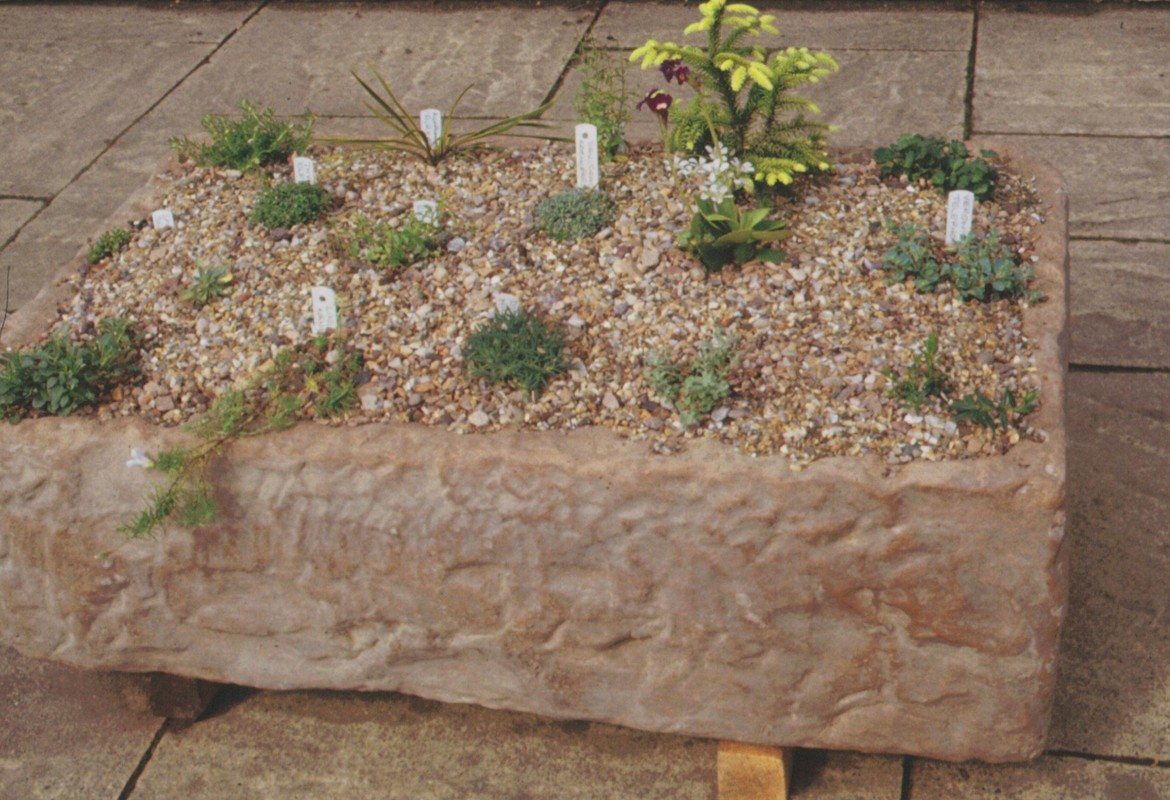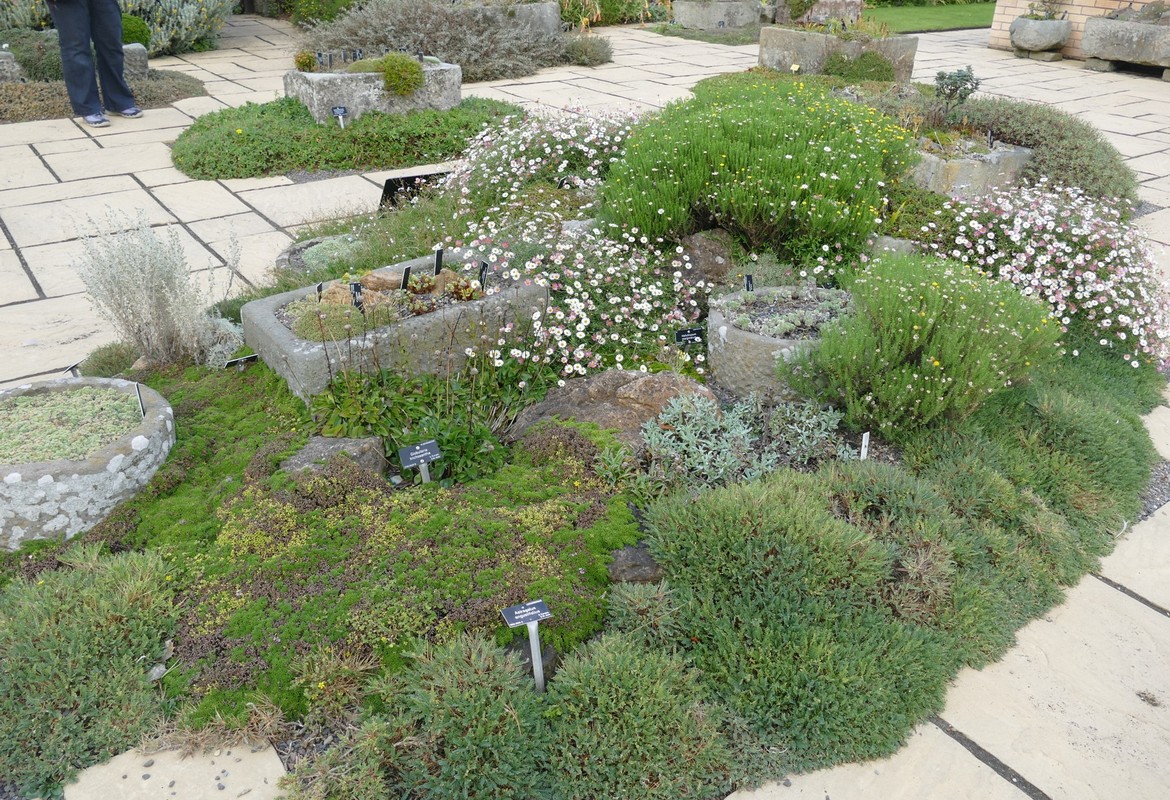
Example of my home made hypertufa trough planted in 2019
Alpine Troughs
By Howard Drury
For many years, original stone troughs have been greatly prized by alpine enthusiasts for growing choice specimens in natural stone. In the 1930s Clarence Elliott took some pig and horse troughs to the Chelsea Flower Show before being banished from the main marquee for such artifices. Stone troughs are difficult to obtain nowadays, expensive and heavy to transport. Furthermore, it is often necessary to drill drainage holes to give at least one square inch of drainage hole to each square foot of trough area.
Various alternatives have been tried, some more successful than others. In the late 1940s and 1950s many people obtained glazed sinks, typically quite deep with a high glaze finish sometimes using them to grow alpines, perhaps coating them with a mixture of sharp sand, rubbed sphagnum peat and cement to make them resemble a moss covered, well weathered natural stone trough. The old scullery sinks, which were shallower and brown in colour, were sometimes used uncoated.
Experiments have also been made with clay pots of varying designs, fibreglass containers and even old chimney pots. Fine examples can be seen in various gardens where slabs have been placed on breeze blocks or stone blocks and edged with small sections of stone to create a table garden effect. Large sections of tufa can best be employed in this manner.
The ratio of ingredients is normally taken as 1:1:2 (by bulk) using cement, peat and sand. More sand and less peat leads to a stronger but more concrete looking trough, whilst increasing the amount of peat will give a moss covered, soft textured trough which in severe winters may be prone to frost damage.
Glazed sinks should be thoroughly cleaned and coated with an adhesive covering such as Unibond. Two or three coats are advisable, and the last coat mixed with sand and cement to give a bonding layer. The sand and cement should be mixed dry and then moistened peat, which has been rubbed through a 3/8" sieve, added and mixed.
When thoroughly combined, water can be added a little at a time until the mixture is sufficiently moist to adhere to the vertical walls of a glazed trough. The trough is then given a coating approximately 3/4 to 1 in. thick, which is firmed into place with gloved hands and trowelled to leave a natural looking appearance. The trough should then be allowed to dry very slowly; this can be aided by covering with damp hessian sacking etc.
Many people have experimented with the mixture to make troughs by using two cardboard boxes, one placed inside the other, leaving a gap of 1.5 2 ins wide all the way round. Two pieces of broom handle, 2 ins. Long are used to provide drainage holes and ensure the bottom is the correct thickness, these will be knocked out at a later date. Alternatively, 1 in. diameter plastic piping may be used and left in place. The mixture is placed in the bottom of the larger cardboard box and the two broom handles or pipe sections placed in position. The mixture is then consolidated around them as shown in the diagram.
The second box is then placed centrally in position and the mixture can be eased gently in between the inner and outer layers of cardboard until full. To prevent the inner box collapsing, bricks and sand may be placed inside as it is necessary to firm down the mixture between the inner and outer boxes using a piece of wood as a rammer. Once completed, the trough is covered with damp sacking and left to dry out slowly.
Two or three days later the cardboard can be torn off, the sections of broom handle gently tapped out. This is the ideal time to take a wire brush, trowel etc. and remove outer corners and abrade the trough to give a worn appearance, exposing the peat. The trough will then moss over naturally and this can be hastened by coating with sour milk, boiled rice water or, ideally, fresh cow manure, especially if left in a grassy shady place.
A further advance is to take an original trough and take a moulding, using either fibreglass or vinyl, which has to be melted in a special boiler and poured around the original trough. It is kept in place with a wooden framework around the trough. When set, this leaves a rubber like mould, which can be used repeatedly to give an exact replica of the original trough. Colouring agents are available to create sandstone or Cotswold stone like effects, or alternatively quarried and ground up natural stone may be used to replace the sand, and here, to get the true effect of the stone white cement should be used.
Planting
Planting should be done with great care, and any plants selected must be suitably grouped together within the confines of a trough. Invasive plants should be avoided, and sufficient room should always be allowed for the plants to grow slowly together. The planting medium is often based on John Innes No.1 with an additional up to 30% grit to ensure free drainage. This medium is normally placed over a shallow layer of gravel or broken crocks, which in turn may be covered with a woven polythene sheet to prevent the soil fouling the drainage medium.
In larger troughs a small rock garden may be created to allow plants the ideal planting environment, but this will depend on the plant selected and the available space. Planting should be carried out at the correct depth and firmly, the entire surface area can then be covered with a layer of crushed stone, fine gravel etc.
Juniperus communis 'Compressa' and other very dwarf conifers are ideal for troughs. Remember to select plants according to where the trough is to be sited, taking into account aspect such as shade, exposure etc. Indeed with larger troughs these are best planted in situ. Most troughs look best when grouped together and linked with plantings of thymes, saxifrages and sedums, which can be used to hide the bricks on which the troughs are raised from the ground. All troughs should be raised off the ground at least 1 2 inches to ensure free drainage. Among the most commonly used plants are Dianthus alpinus in its various forms and colours; Globularia bellidifolia, only 2 inches high with small thistle like heads of blue during summer, and the semi evergreen Cotoneaster congesta nana, ideal for creeping over the edge of the trough.
One of the smallest hebes, Hebe buchananii 'Minor' is ideal and occasionally offers its small white flowers and Veronica teucrium 'Blue Tit' forms a little trailing mound up to 2 ins. high and will hang over the front edge of the trough. Of the smaller slower growing saxifrages, perhaps the best known is S. cochlearis minor, forming a small silver mound, which S. oppositifolia 'Ruth Draper' is one of the best of the trailing forms providing welcome colour during March and early April. Phlox douglasii provides many named forms of bun like plants that flower in June such as P. 'Kelly's Eye' and there are several even smaller forms.
Plants must not be allowed to go short of water during dry periods. Generally, no feeding is required and provided suitable plants have been selected at the outset, little or no pruning should be necessary. Do not allow the taller growing subjects to become so high that they screen smaller plants growing behind them. A certain amount of general maintenance will improve the appearance of the trough. Weeds and unwanted seedlings can be removed (with tweezers if necessary) and dead heading should be carried out regularly, unless it is intended to collect the seeds. Top dress with fresh grit to keep the trough looking tidy and to aid drainage. Alpine troughs, therefore, must make the ideal form of gardening, particularly for those who have little time to spare but want the enjoyment and pleasure of growing rarities.
Suitable Plants
Alyssum serpyllifolium prostrate mats of silver foliage with yellow flowers 1 in.
Antennaria dioica 'Minima' condensed form, 3in stems with pink flowers.
Arabis ferdinandi coburgii 'Variegata' tiny variegated form white flowers summer.
Erodium chamaedryoides 'Bishops Form' large pink flowers all summer, 3in.
Helichrysum milfordae white flowers over silver mats of foliage in summer, 1 in.
Morisia monanthos tiny tufts of foliage, minutes yellow flowers all summer, 1 in.
Oxalis enneaphylla white flowers over silvery folded leaves 2 in.
Phlox douglasii in var. tough compact plants, covered in flower, early summer.
Primula x bilekii pink flowers with white eye, early spring, 1in.
Saxifraga 'Cranbourne' blue grey foliage, pink flowers in early spring 2in.
Silene acaulis 'Penduncalata' almost stemless pink flowers all summer 1 in.
Salix x boydii shrub with grey green leaves, cream catkins in spring, slow growing 12 in.
The above information is taken from 'Alpines and Rock Plants' by Howard Drury, published by Boxtree but now out of print, although copies may still be found in remainder shops etc.
Further reading
There are many books available on the subject of Alpine Gardening, and the list below is only a very small selection.
Manual of Alpine Plants by W. Ingwerson
Propagation of Alpine Plants by Lawrence Hills
Rock Gardens by W. Schacht
Dwarf Bulbs by B. Mathew
The information given in this Fact Sheet is provided in good faith. It is however of necessity general information and advice on the topic. Howard Drury will not be under any liability in respect of the provision of such advice and information, and you are strongly advised to seek independent advice on any particular gardening problems or queries you may have, preferably from experts who can (when appropriate) inspect the problem before providing advice.
(C) 2022. This material has been produced by Howard Drury and must not be reproduced in part or full without the written consent of Howard Drury, Kings Heath, Birmingham, B13 0SJ.
JHD/19/02/2022









